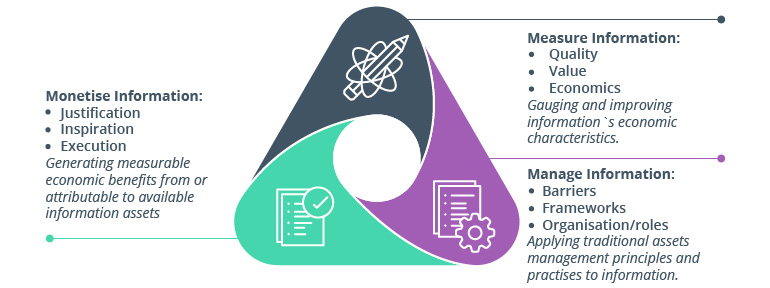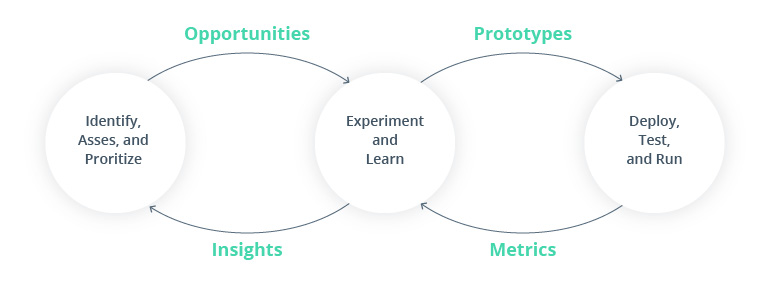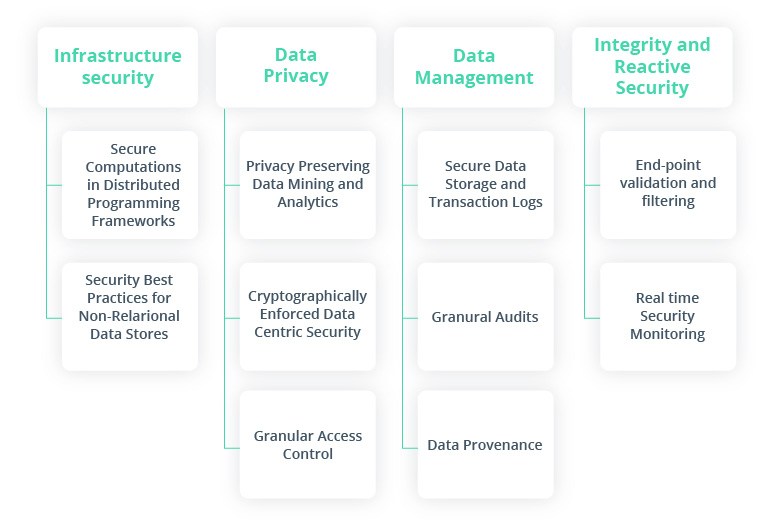Was it just about 10 years ago that “big data” sounded like a somewhat abstract, distant, futuristic term and hardly any could predict big data trends? In fact, there was lots of data back then, and everybody was trying to put it to good use with the help of BI tools and multi-layered reporting, but it wasn’t exactly considered the next big thing.
Just a decade later, the unrestricted growth of social networks, global online services, wearables, affordable and functional IoT components, and other connected devices has resulted in a dramatic increase in the volume of data generated by these devices on a daily basis. And we now have a much better idea of how to handle it properly.
Let’s take a look at the areas where today’s progress in the big data domain will have the most notable effect and define vital big data trends:
- Infonomics
- DataOps
- Interconnectivity
- Quantum computing
- Data security
- The cloud is a given
According to Statista, the combined volume of data generated in 2024 alone will be close to 150 zettabytes, which is a staggering figure. Companies able to harness its potential, distinguish the most promising solutions among all the big data industry trends, and adopt the hottest technologies in this domain will enjoy countless advantages and take the lead in the competitive market.
Infonomics
According to Doug Laney, former VP of Gartner, infonomics, one of the latest trends in big data, is “the theory, study and discipline of asserting economic significance to information. It strives to apply both economic and asset management principles and practices to the valuation, handling and deployment of information assets.”
In plain English, infonomics treats data as a commodity-like substance. After all, if data can substantially improve forecasting results and therefore boost sales or minimize losses; if it can help target the right consumer cohorts with the right products; and if it can improve public safety — why shouldn’t it be treated as a valuable resource, just like rare metals or fossil fuels?
Infonomics model: measure, manage, and monetize information

Source: Gartner
In the future, data will be gaining more and more market traction as an object of trade and exchange, and the fuel powering the rapidly growing industries of data science and ML engineering. Even today, big data is something that many global businesses simply won’t survive without, which means that business leaders should be treating their big data strategies with all seriousness.
Some examples of data being sold as a product can be drawn from world-renowned sources of business intelligence, such as NielsenIQ, Acxiom, and, more recently, Dawex, an innovative global data exchange marketplace.
DataOps
In a world getting increasingly dependent on data and data-driven decisions, trends in big data analytics and the overall success of big data initiatives will be governed by DataOps, an emerging operational framework and a set of best practices in the big data space.
The DataOps cyclic process

Source: Ryan Gross, Medium
Those who say that DataOps is essentially DevOps for data are right in that DataOps can do as much good for data science as DevOps has done for development. However, it’s a much wider notion, despite the apparent semantic similarity. IBM, for instance, defines DataOps, as “the orchestration of people, process, and technology to deliver trusted, high-quality data to data citizens fast”.
Similarly to DevOps, which does not consist of continuous integration and continuous delivery only, DataOps as one of the key big data analytics trends is more of a philosophy than a set of delivery approaches. This fusion of architectural approaches, cultural elements, agile practices, lean production techniques, statistical process control (SPC), and good old DevOps strives to achieve the following:
- Exceptional quality of results coupled with a very low error rate
- Effective collaboration across teams, business units, companies, technology stacks, and heterogeneous environments
- Rapid adaptation to changing requirements and conditions
- Non-stop, high-speed delivery of meaningful, high-value insights to users
- Ease of measuring and monitoring data flows
- Full transparency of results
Interconnectivity
One of the greatest challenges that adopters of big data technologies will face is how to deal with disparate and siloed data sources. And their attempts to solve this problem leads to the appearance of new big data industry trends.
Every large organization operates multiple systems scattered across departments, production facilities, branches, and geographies. Each system may potentially have a unique data storage format and a set of security requirements, thus creating a need for complex ETL manipulations.
The success of any digital transformation will depend heavily on the ability to centralize data processing and storage, create company-wide data pipelines, and implement universally accessible data analysis tools.
The key hurdles for resolving interconnectivity issues will include the following:
- Developing an effective data engineering strategy
- Synchronizing data streams across all data sources
- Making data pipelines flexible and scalable to withstand future growth
- Implementing reliable data security measures
- Embedding accuracy and quality control mechanisms across the board
- Devising an effective and efficient cloud data storage model
These operational challenges can only be solved by means of tight cooperation between a company’s business and technology stakeholders, as well as an in-house or hired team of professional data engineers and data analysts.
Quantum computing
The notion of big data future trends is inseparable from quantum computing. As the amount of data generated by computer systems keeps growing exponentially, it will inevitably come into conflict with the limitations of today’s hardware approaching its physical limits, as per Moore’s law. Dramatic performance improvements will require a “quantum leap” in the raw processing power of future CPUs, and quantum computing will be the answer and another mighty solution out of all spectrum of latest trends in big data.
Quantum computing may still be in the making, but its future potential is not to be underestimated. Major players like IBM and Google, as well as a number of high-tech startups, have spotted its potential amongst other trends in big data analytics and are already making steady progress in this area. Once mature enough and commercialized, the technology will be put to good use by large enterprises and science labs around the world to tap into the vast array of data that remains untouched and unprocessed today.
As hardware manufacturers push the envelope to harness those cubits, software companies like Microsoft are laying a foundation for the future of big data science by developing corresponding frameworks and online platforms — check out Azure Quantum, for example.
Data security
In the world of big data, cybersecurity is an equally big deal, outlining another tendency within big data future trends. Data analysis systems can be deployed in or collect data from such areas as finance, healthcare, insurance, and many others — all rife with confidential personal and business information. Compromising this data may have severe ramifications and pose major risks to affected individuals and companies.
At the same time, security measures cannot be implemented exclusively at the storage level. Big data systems have complex architectures and consist of multiple distributed components and data sources, which makes the enforcement of security policies a challenging, never-ending process.
Given the current technologies and big data analytics trends, the following potential security-related issues should be taken into account:

Source: Shaveta Jain, Researchgate
Companies that are just starting to follow trends in big data analytics and think of the adoption of big data technologies may be concerned about having little control over sensitive data that’s stored and processed in public clouds using third-party tools. In this case, a multi-cloud strategy can help maintain a healthy balance between security and operational efficiency.
The cloud is a given
The analysis of the next-gen big data trends results in a bold forecast that the data domain growth and development lies in the cloud. Offering unparalleled flexibility in every aspect and virtually infinite ad hoc computing resources unattainable for most companies, cloud platforms are the number one choice for any business considering a big data adoption program.
Platforms like Microsoft Azure, Google Cloud, and Amazon Web Services provide an unprecedented set of products, tools, and services for designing, building, and operating a big data solution of any size and complexity. In addition to these industry leaders, dozens of other cloud computing providers offer alternative services tailored to particular application areas — often at a lower price and with better SLAs.
Conclusion
Latest trends in big data promise us quite a bright future, primarily because big data is steadily turning into the essence of everything. Global services like Google Search and Facebook have hundreds of internal services and components based on big data, AL/ML, and deep learning under their hood — and most users don’t have the slightest idea that they are the driving force behind the magic they love.
The ability to recognize worthy options among the big data industry trends, implement the right solutions accordingly, and leverage the benefits of big data is crucial to the survival and well-being of any modern business, whether it’s just starting to undergo digital transformation or is way past that point. These days, being an IT manager or company owner, you simply cannot remain ignorant of the steady drift toward data-driven decisions — you’ll need a solid big data adoption strategy that will ensure your competitiveness in the years to come.
Making big data an integral part of your long-term digital strategy is your first step into a more effective future. We can help you prioritize your goals, create a realistic roadmap, execute your plan, and keep improving your big data pipeline. Don’t hesitate to contact us if you’re looking for professional insights from trusted data experts.

